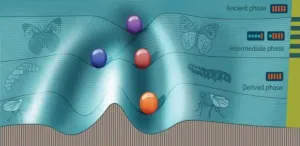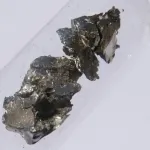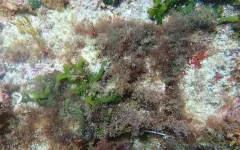(Press-News.org) Computer simulations of cells evolving over tens of thousands of generations reveal why some organisms retain a disused switch mechanism that turns on under severe stress, changing some of their characteristics. Maintaining this "hidden" switch is one means for organisms to maintain a high degree of gene expression stability under normal conditions.
Tomato hornworm larvae are green in warmer regions, making camouflage easier, but black in cooler temperatures so that they can absorb more sunlight. This phenomenon, found in some organisms, is called phenotypic switching. Normally hidden, this switching is activated in response to dangerous genetic or environmental changes.
Scientists have typically studied this process by investigating the changes undergone by organisms under different circumstances over many generations. Several years ago, for example, a team bred generations of tobacco hornworm larvae to observe and induce color changes similar to those that occurred in their tomato hornworm relatives.
"Computer simulations, when built on reasonable assumptions and conducted under careful control, are a very powerful tool to mimic the real situation," says KAUST computational bioscientist Xin Gao. "This helps scientists observe and understand principles that are otherwise very difficult, or impossible, to observe by wet-lab experiments."
Gao and KAUST research scientist Hiroyuki Kuwahara designed a computer simulation of the evolution of 1,000 asexual microorganisms. Each organism was given a gene circuit model for regulating the expression of a specific protein X.
The simulation evolved the population over 90,000 generations. The original founding population had identical nonswitching gene circuits and evolved over 30,000 generations, collectively called the ancient population, under stable conditions. The next 30,000 generations, called the intermediate population, were exposed to fluctuating environments that switched every 20 generations. The final 30,000 generations, the derived population, were exposed to a stable environment.
The individuals in the ancient and derived populations, who evolved in stable environments, both had gene expression levels that were optimized for stability. But they were different: the ancient population's stability did not involve phenotypic switching, while the derived population's did. The difference, explains Kuwahara, stems from the intermediate population, in which switching was favored in order to deal with the fluctuating conditions.
The simulations suggest that populations of organisms maintain their switching machinery over a long period of environmental stability by gradually evolving low-threshold switches, which easily switch in fluctuating circumstances, to high-threshold switches when the environment is more stable.
This is easier, says Kuwahara, than reverting to a nonswitching state through small mutational shifts. "Instead, we end up with a type of 'hidden' phenotypic switching that acts like an evolutionary capacitor, storing genetic variations and releasing alternative phenotypes in the event of substantial perturbations," Kuwahara says.
The team next plans to use computer simulations to study more complex biological systems while also interactively collaborating with researchers conducting wet-lab experiments. Their aim is to develop theoretical frameworks that can be experimentally validated.
INFORMATION:
Scientists at the Institute of Physics of the University of Tartu have found a way to develop optical quantum computers of a new type. Central to the discovery are rare earth ions that have certain characteristics and can act as quantum bits. These would give quantum computers ultrafast computation speed and better reliability compared to earlier solutions. The University of Tartu researchers Vladimir Hizhnyakov, Vadim Boltrushko, Helle Kaasik and Yurii Orlovskii published the results of their research in the scientific journal Optics Communications.
While in ordinary computers, the units of information are binary digits or bits, in quantum computers the units are quantum bits or qubits. In an ordinary computer, information is mostly ...
Tsukuba, Japan - Out with the old, in with the new, as the New Year's saying goes, but not where the marine environment is concerned. Researchers from Japan have discovered that ocean acidification keeps algal communities locked in a simplified state of low biodiversity.
In a study published on 11th January 2021 in Global Change Biology, researchers from the University of Tsukuba have revealed that as oceanic carbon dioxide levels rise, the biodiversity and ecological complexity of marine algal communities decline.
Ocean acidification is the continuing increase in the acidity of the Earth's oceans, caused by the absorption of atmospheric carbon dioxide (CO2). ...
The celebrations in the 250th anniversary of the birth of Ludwig van Beethoven would not be the same without Herbert von Karajan's brilliant performances conducting Beethoven's memorable symphonies. The execution of any musical symphony is a hugely difficult task, demanding very significant skills on the part of each individual musician - but perhaps the most difficult task lies with the conductor who has to orchestrate the musicians into making the music cohesively come alive and speak to our deepest emotions.
In many ways the human brain is like an orchestra, where different regions perform very different types of processing, such ...
A new study conducted at the University of Turku, Finland, shows that patients with a schizophrenia spectrum disorder have an increased risk of Parkinson's disease later in life. The increased risk may be due to alterations in the brain's dopamine system caused by dopamine receptor antagonists or neurobiological effects of schizophrenia.
The record-based case-control study was carried out at the University of Turku in collaboration with the University of Eastern Finland. The study examined the occurrences of previously diagnosed psychotic disorders and schizophrenia in over 25,000 Finnish Parkinson's disease (PD) patients ...
Tsukuba, Japan - A team of researchers lead by the University of Tsukuba have created a new theoretical model to understand the spread of vibrations through disordered materials, such as glass. They found that as the degree of disorder increased, sound waves traveled less and less like ballistic particles, and instead began diffusing incoherently. This work may lead to new heat- and shatter-resistant glass for smartphones and tablets.
Understanding the possible vibrational modes in a material is important for controlling its optical, thermal, and mechanical properties. The propagation of vibrations in the form of sound of a single ...
Scientists of Tomsk Polytechnic University jointly with colleagues from the University of Lille (Lille, France) synthetized a new material based on reduced graphene oxide (rGO) for supercapacitors, energy storage devices. The rGO modification method with the use of organic molecules, derivatives of hypervalent iodine, allowed obtaining a material that stores 1.7 times more electrical energy. The research findings are published in Electrochimica Acta academic journal (IF: 6,215; Q1).
Photo: modified rGO supercapacitor electrodes
A supercapacitor is an electrochemical device for storage and release ...
Bone turnover markers (BTMs) in blood and urine are useful tools in monitoring osteoporosis treatment effects and may be useful for improving patient adherence.
In 2011, a Joint Committee on Bone Metabolism of the International Osteoporosis Foundation (IOF) and the International Federation of Clinical Chemistry and Laboratory Medicine (IFCC) designated Procollagen type I N-propeptide (PINP) and the C-terminal telopeptide of type I collagen (β-CTX) in blood as reference bone turnover markers for bone formation and bone resorption, respectively, in osteoporosis. However, the effective clinical implementation of ...
Over the last half-century, the probability of heat extreme events has changed by orders of magnitude in almost every region of the world, with occurrences that are now up to a hundred times more in respect to a century ago. Of all-natural disasters, extreme high temperature events are the main cause of weather-related mortality and they are also expected to be the main factor responsible for additional deaths due to climate change in the coming years.
In cities, the heat island effect creates higher temperatures than in vegetated areas. But conditions within urban areas are not equal in all their parts - either due to their physical form or to the specific needs or vulnerabilities of inhabitants - therefore not all districts ...
The NASA/ESA Hubble Space Telescope has observed the supernova remnant named 1E 0102.2-7219. Researchers are using Hubble's imagery of the remnant object to wind back the clock on the expanding remains of this exploded star in the hope of understanding the supernova event that caused it 1700 years ago.
The featured star that exploded long ago belongs to the Small Magellanic Cloud, a satellite galaxy of our Milky Way located roughly 200 000 light-years away. The doomed star left behind an expanding, gaseous corpse -- a supernova remnant -- known as 1E 0102.2-7219.
Because the gaseous knots in this supernova ...
The researchers published their report in the Journal Nature Communications from 15 January 2021.
When the communication breaks down
Spinal cord injuries caused by sports or traffic accidents often result in permanent disabilities such as paraplegia. This is caused by damage to nerve fibers, so-called axons, which carry information from the brain to the muscles and back from the skin and muscles. If these fibers are damaged due to injury or illness, this communication is interrupted. Since severed axons in the spinal cord can't grow back, the patients suffer from paralysis and numbness for life. To date, there are still no treatment options that could restore the lost functions ...



